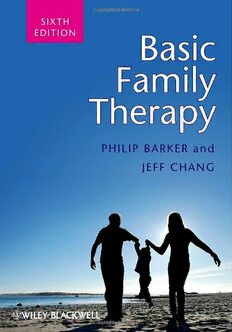
Basic Family Therapy PDF
Preview Basic Family Therapy
Basic Family Therapy Basic Family Therapy Sixth Edition Philip Barker MB, BS, FRCPsych, FRCP(C), DPM, DCH Professor Emeritus of Psychiatry, University of Calgary Jeff Chang Ph.D., R.Psych. Associate Professor, Athabasca University Director, The Family Psychology Centre A John Wiley & Sons, Ltd., Publication Thiseditionfirstpublished2013,(cid:2)C 2013byJohnWiley&Sons,Ltd (cid:2)C 1981,1986,1992,1998,2007PhilipBarker Wiley-BlackwellisanimprintofJohnWiley&Sons,formedbythemergerofWiley’sglobal Scientific,TechnicalandMedicalbusinesswithBlackwellPublishing. Registeredoffice: JohnWiley&Sons,Ltd,TheAtrium,SouthernGate,Chichester, WestSussex,PO198SQ,UK Editorialoffices: 9600GarsingtonRoad,Oxford,OX42DQ,UK 111RiverStreet,Hoboken,NJ07030-5774,USA Fordetailsofourglobaleditorialoffices,forcustomerservicesandforinformationabouthowto applyforpermissiontoreusethecopyrightmaterialinthisbookpleaseseeourwebsiteat www.wiley.com/wiley-blackwell. Therightoftheauthortobeidentifiedastheauthorofthisworkhasbeenassertedinaccordance withtheUKCopyright,DesignsandPatentsAct1988. Allrightsreserved.Nopartofthispublicationmaybereproduced,storedinaretrievalsystem,or transmitted,inanyformorbyanymeans,electronic,mechanical,photocopying,recordingor otherwise,exceptaspermittedbytheUKCopyright,DesignsandPatentsAct1988,withoutthe priorpermissionofthepublisher. Designationsusedbycompaniestodistinguishtheirproductsareoftenclaimedastrademarks.All brandnamesandproductnamesusedinthisbookaretradenames,servicemarks,trademarksor registeredtrademarksoftheirrespectiveowners.Thepublisherisnotassociatedwithanyproduct orvendormentionedinthisbook.Itissoldontheunderstandingthatthepublisherisnotengaged inrenderingprofessionalservices.Ifprofessionaladviceorotherexpertassistanceisrequired,the servicesofacompetentprofessionalshouldbesought. Thecontentsofthisworkareintendedtofurthergeneralscientificresearch,understanding,and discussiononlyandarenotintendedandshouldnotberelieduponasrecommendingorpromoting aspecificmethod,diagnosis,ortreatmentbyhealthsciencepractitionersforanyparticularpatient. Thepublisherandtheauthormakenorepresentationsorwarrantieswithrespecttotheaccuracyor completenessofthecontentsofthisworkandspecificallydisclaimallwarranties,includingwithout limitationanyimpliedwarrantiesoffitnessforaparticularpurpose.Inviewofongoingresearch, equipmentmodifications,changesingovernmentalregulations,andtheconstantflowof informationrelatingtotheuseofmedicines,equipment,anddevices,thereaderisurgedtoreview andevaluatetheinformationprovidedinthepackageinsertorinstructionsforeachmedicine, equipment,ordevicefor,amongotherthings,anychangesintheinstructionsorindicationofusage andforaddedwarningsandprecautions.Readersshouldconsultwithaspecialistwhere appropriate.ThefactthatanorganizationorWebsiteisreferredtointhisworkasacitationand/or apotentialsourceoffurtherinformationdoesnotmeanthattheauthororthepublisherendorses theinformationtheorganizationorWebsitemayprovideorrecommendationsitmaymake. Further,readersshouldbeawarethatInternetWebsiteslistedinthisworkmayhavechangedor disappearedbetweenwhenthisworkwaswrittenandwhenitisread.Nowarrantymaybecreated orextendedbyanypromotionalstatementsforthiswork.Neitherthepublishernortheauthorshall beliableforanydamagesarisingherefrom. LibraryofCongressCataloging-in-PublicationData Barker,Philip,1929– Basicfamilytherapy/PhilipBarkerandJeffChang.–6thed. p.;cm. Includesbibliographicalreferencesandindex. ISBN978-1-119-94505-5(pbk.) I.Chang,Jeff,1958– II.Title. [DNLM:1.FamilyTherapy.WM430.5.F2] RC488.5 616.89(cid:3)156–dc23 2013006030 AcataloguerecordforthisbookisavailablefromtheBritishLibrary. Wileyalsopublishesitsbooksinavarietyofelectronicformats.Somecontentthatappearsinprint maynotbeavailableinelectronicbooks. Coverimage:iStock(cid:2)C NaomiBassitt CoverdesignbySteveThompson Setin10/12ptTimesbyAptara®Inc.,NewDelhi,India 1 2013 Contents Foreword ix Introduction xiii 1 TheDevelopmentofFamilyTherapy 1 Familytherapy’searlyyears 1 1990sandthenewmillennium 9 Summary 13 References 14 2 HealthyFamiliesandTheirDevelopment 19 Ethnicvariations 21 Thefunctionsoffamilies 21 Familydevelopment 22 Theclinicalimportanceoffamilydevelopmentalstages 23 Optimalfamilyfunctioning 24 Summary 26 References 26 3 SomeBasicTheoreticalConcepts 27 Theoriesderivedfromindividualandgrouppsychotherapy 27 Othertheoriesthathavebeenusedinfamilytherapy 28 Otherconceptsandterms 41 Summary 46 References 46 4 AdoptingandRefiningaModelofFamilyTherapy 50 Thenatureoftheoriesandmodels 50 Developingyourmodeloffamilytherapy 52 Selectingandadaptingamodeloffamilytherapy 54 Summary 54 References 55 5 ModelsfortheAssessmentofFamilies 57 Criticaldistinctionsinassessment 58 Conceptualapproachestofamilyassessment 59 TheBeaversSystemsModelofFamilyFunctioning 64 TheDarlingtonFamilyAssessmentSystem 66 Respectiveutilityoffamilyassessmentmodels 67 vi Contents Summary 68 References 68 6 TheFamilyDiagnosticInterview 70 Theinitialcontact 70 Joiningthefamilyandestablishingrapport 71 Definingthedesiredoutcome 75 Reviewingthefamily’shistory,determiningitsdevelopmental stageandconstructingagenogram 75 Assessingthecurrentfunctioningofthefamily 79 Developingadiagnosticformulation 83 Offeringthefamilyfeedbackandrecommendations 84 Discussingandarrangingthenextstep 85 Feedbacktoreferringprofessionals 86 Summary 86 References 87 7 EstablishingTreatmentGoals 88 Definingthedesiredstate 89 Intermediateandfinalgoals 92 Motivatingfamiliestoconsiderandsetobjectives 92 Summary 93 References 94 8 WhenIsFamilyTherapyIndicated? 95 Basiccriteriaforemployingfamilytherapy 96 Differingviewsontheplaceoffamilytherapy 97 Someviewsonindications 98 The‘decisiontree’ 100 Contraindicationsforfamilytherapy 103 Summary 105 References 106 9 PracticalPointsintheTreatmentofFamilies 108 Involvingreluctantfamilymembers 108 Maintainingatherapeuticalliance 113 Involvingchildreninfamilysessions 115 Thetherapist’suseofself 118 Transferenceissues 118 Contracts 119 Thespacingofsessions 119 Confidentiality 120 Observers 121 Co-therapy 123 Summary 125 References 125 Contents vii 10 CommonFamilyProblemsandTheirTreatment 127 Introduction 127 Taskaccomplishmentproblems 127 Seriousbasictaskaccomplishmentproblems 132 Communicationproblems 134 Poorlydefinedanddysfunctionalrolepatterns 137 Summary 144 References 144 11 ComplexProblemsandSecond-OrderChange 147 Interruptingproblempatterns 147 Techniquesfocusingonchangingmeaning 156 Theuseofhumour 161 Strategicteams 162 Asecond-ordercyberneticapproach:therapyas conversation 163 Summary 167 References 168 12 OtherTherapeuticApproaches 172 Experientialapproaches 172 Videoplayback 175 Familymusictherapy 175 Familyarttherapy 176 Familyplaytherapy 177 Familyresilienceandecologicalinterventions 178 Familytherapyandseriousmentalillness 182 Mindfulnesspractices 186 Innovativeformatsforservicedelivery 187 Conclusion 190 References 190 13 AMethodofTherapy 199 Treatmentbystages 200 Terminationinfamilytherapy 211 Summary 212 References 213 14 CoupleTherapy 215 Thehistoryofcoupletherapy 215 Generalconsiderationsincoupletherapy 217 Currentapproachestocoupletherapy 220 Divorcetherapyandmediation 227 Sextherapy 228 Summary 230 References 231 viii Contents 15 TerminatingTreatmentandDealingwithTreatment Interruptions 236 Treatmentcontracts 236 Opencontracts 237 Indicationsforendingtreatment 238 Howtoterminatetreatment 241 Terminationtasksandritual 243 Emotionalandpsychologicalaspectsoftermination 243 Follow-up 244 Dealingwithtreatmentinterruptions 245 Summary 246 References 247 16 TeachingandLearningFamilyTherapy 248 Wholearnsfamilytherapy? 250 Thedifferentpossiblelearningexperiences 251 Methodsoflearningfamilytherapy 251 Audiovisualaids 253 Objectives 254 Learningfamilytherapyskills 255 Thecontentoftraining 256 Supervision 257 Learningtosupervise 258 Consultation 260 Summary 263 References 263 17 ResearchinFamilyTherapy 265 Whyisfamilytherapyresearchimportant? 266 Isfamilytherapyeffective? 266 Whatmakesfamilytherapyeffective? 267 Isfamilytherapycost-effective? 270 Howcanpractitionersbemoreinvolvedinresearch? 270 Summary 271 References 272 18 EthicsandFamilyTherapy 275 Informedconsent 277 Therapists’values 278 Confidentiality 279 Ethicaldecisionmaking 281 Keepinginformedanduptodate 283 Ethicalissuesinfamilytherapyresearch 283 Summary 284 References 284 Appendix 286 Index 291 Foreword It was a pleasure and a privilege to read the sixth edition of this book. It is more difficult, however, to write an adequate introduction, as there are few enthusiastic phrases that have not already been invoked to describe the various editions of Philip Barker’s book that have appeared since the first in 1981. The previous editions have been described as ‘A Classic Book for Clinicians’ (British Journal of Psychiatry) and as ‘Comprehen- sive and Stimulating’ (Journal of Clinical Psychiatry). In Contemporary Psychiatry, an enthusiastic reader gushed, ‘There is an exhilaration at being exposed to a thorough and articulate scholar,’ while suggesting the book ‘should be required reading for all students in mental health disciplines’. Iwouldliketobeclearthatthisisaneminentlyreadablebookforthose whoarenewtothediscipline.Anyonewhoisnotnewtothediscipline,how- ever,andhasseenapreviousversionwillknowthis;readersandreviewers before me have commented on the skill of the author, who could write a book on the complex and theoretically diverse domain of family therapy thatisatoncescholarlyyetthoroughlyaccessible. Readersofpreviouseditionswillfindtheupdateworthwhileandmaybe reassuredtonoteafamiliarorderingtomanyofthechapters.Fornewread- ers,aquicktourofthebookiswarrantedtoprovidearoadmap.Chapter1 reviewstheevolutionoffamilytherapybeginninginthe1950sand,consis- tentwithpreviouseditions,usesadecade-by-decadeapproachtochronicle theoretical advances in the field. The chapter succinctly summarizes the influenceofthepostmodernapproachonfamilytherapy.Chapter2moves to a discussion of healthy families and their development, including a dis- tinctionbetween‘normal’and‘healthy’families.Theauthorsusetheframe- workprovidedbyBarnhillandLongotodiscussthedevelopmentalstages of families. Chapter 3 reviews important theoretical concepts underlying family therapy, such as theoretical influences derived from individual and group therapy. The authors reflect on the importance of systems thinking andsystemtheory,controltheory,cybernetics,learningtheoryandcommu- nication theory, returning to the influence of postmodern approaches and thecollaborativemodel. Chapter4beginsthetransitiontotheclinicalenvironmentwithacogently articulatedargumentforwhyitisimportantthatthetherapistshaveawell- developedmodeltoguidetherapeuticencounters.BothPhilipBarkerand JeffChangprovidetheirownperspectivesonhowtheyacquiredcoherent modelsoftherapy,finishingthechapterwithsomesuggestionsonselecting andadaptingamodeloftherapy. x Foreword Thebookthentransitionsintothemostclinicallyorientedsections,begin- ningwithareviewofvariousmethodsforassessingfamilies(Chapter5)and progressingthroughsettingoftreatmentgoals(Chapter7),indicationsand contraindicationsforfamilytherapy(Chapter8)andpracticaltipsfordeal- ing with issues such as reluctant or missing family members (Chapter 9). Chapter11outlinesapproachesforcomplexproblems,includingproviding adetailedapproachto,andaclinicalvignetteof,aparadoxicalintervention. Chapter13returnsustoamoretheoreticallyorienteddiscussionthatknits thevariousclinicalchaptersintoacoherentmethodofconductingtherapy. Throughoutthechaptersthereareconciseandeffectiveclinicalvignettes thathighlightimportantconceptsandkeepthereaderfocusedonthereal world.Morerecenteditionsofthisbookhadincorporatedthe(then)emerg- ingperspectiveoffamilytherapyasacollaborativeprocessinwhichthefam- ilymembersandthetherapistarepartners.Thisperspectiveiswoveninto thefabricofthistextand,Ibelieve,contributestothewarmththatemanates from the pages. It seems clear that these are therapists who are fully and respectfully engaged with the families they encounter, not only treating them,butlearningfromthem,alwaysunderstandingsomethingnew.Ifitis possibleforabooktonotonlyeducatebuttomodelanapproachtotherapy, thisonedoesso. Theremainingchaptersdealwith‘specialtyissues’.Chapter14isdevoted specificallytocouplestherapy,whileChapter15dealswithterminationof treatment and interruptions. As in earlier editions, the book includes not onlyanoutlineofhowtoapproachfamilytherapyfromaclinicalperspective, butalsofromtheeducationalandresearchdomains.Chapter16providesan overview of teaching family therapy, including objectives, approaches and learning to supervise. Rounding out the tour, Chapter 17 reviews topical issuesinresearch,includingasectiononhowfamilytherapistsmaybemore involvedinresearch. PhilipandJeffnoteintheirintroductionthatthefieldoffamilyfunctioning isbecomingmorecomplex,whichincreasesthechallengeofproducingatrue beginner’s textbook. They have risen fully to the challenge and the result isasuperblyenjoyableandinformativediscussionofpracticalapproaches tofamilytherapy.Thishasbeentheauthors’firstexperienceofturningthe extremelysuccessfulsingle-authorededition(PhilipBarkerwrotethefirst fiveeditionsasasoleauthor)intoajointeffortandthattooappearstohave beenaccomplishedwithnoappreciabledifficulty.Howmanydraftspassed betweenthem,Idonotknow,butthisversionisseamlessinvoice,levelof detailandfocusontheclinicalsetting. I would challenge any reader to identify the sections written by one or the other with any reliability. The authors also write of their fascination withfamilytherapyand,assuggestedabove,thisshinesthrougheachsec- tion. Their obvious pleasure and enthusiasm for helping families, and the creative, flexible but theoretically grounded approaches they describe for approachingfamiliescanonlycomefromtherapistswhohavebecomehighly fluentintheirtherapeuticlanguages. Foreword xi The only thing disappointing about this book is that it left me wanting something that I am doubtful I will receive—Beyond the Basics of Family Therapywrittenwiththesamerelaxed,engagingandclinicallyrelevantstyle. GlendaM.MacQueen,MD,FRCPC,PhD. ViceDean,FacultyofMedicine UniversityofCalgary Canada
